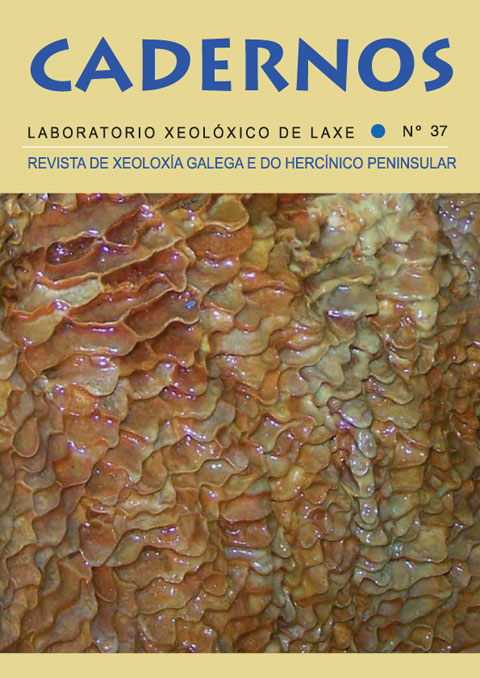First data on testate amoebae in speleothems of caves in igneous rocks
Main Article Content
Abstract
The testate amoebae form part of the habitual troglobios in caves developed in igneous rocks (plutonic and volcanic) where the little light, the persistence of humidity, the availability of silica and organic matter allow these protozoa to develop their biological cycle. This work presents a first inventory of species of amoebae testate identified in caves in igneous rocks from different parts of the World.
Keywords:
Downloads
Article Details
References
Aoki, Y., Hoshina, M., Matsubara, T. (2007). Silica and testate amoebae in a soil under pineoak forest. Geoderma 142: 29-35.
Armynot du Chatelet, E., Guillot, F., Recourt, P., Ventalon, S., Tribovillard, N. (2010). Influence of sediment grain size and mineralogy on testate amoebae test construction. Comptes rendus - Geoscience. 342(9), 710-717.
Bastian, F., Alabouvette, C., Saiz-Jimenez, C. (2009). Bacteria and free-living amoeba in the Lascaux Cave. Res. Microbiol. 160(1), 38-40.
Beinlich, A., Austrheim, H. (2012). In situ sequestration of atmospheric CO2 at low temperature and surface cracking of serpetinized peridotite in mine shafts. Chemical Geology, 332-33, 32-44.
Caldcleugh, A. (1829). On the geology of Rio de Janeiro. Trans. Geol. Soc. London, 2, 69-72.
Coppellotti, Krupa O., Guidolin, l. (2003). Taxonomy and ecology of ciliate fauna (Protozoa, Ciliophora) from karst caves in North-East Italy. Subterr. Biol. 1: 3-11.
Clarke, K. J. (2003). Guide to the identification of soil protozoa - testate amoebae. Soil Biodiversity Programme Research Report No. 4 ed. D. W. Sutcliffe, editor. The Ferru House, Far Sawrey, Ambleside, Cumbria: CEH-Windermere in collaboration with the Freshwater Biological Association.
Forti, P. (2001). Biogenic speleothems: an overview. Int. J. Sepeleol., 30ª (1/4), 39-56.
Forti, P. (2005). Genetic processes of cave minerals in volcanic environments. An overview. Journal of Cave and karst studies, v. 67, nº 1, 3-13.
García-Sánchez, A. M.,Ariza, C., Ubeda, J. M., Martín-Sánchez, P. M., Jurado, V., Bastian, F., Alabouvette, C., Saiz- Jiménez, C. (2013). Free-living amoebae in sediments from the Lascaux Cave in France. International Journal of Speleology. 42(1), 9-13.
Kashima, N., Irie, T., Kinoshita, N. (1987). Diatom contribution of coralloid speleothems, from Togawa-Ssakaidani-Co cave in Miyazaki Prefecture, Central Kyushu, Japan. International Journal of Speleology, 16, 95-1200.
Lousier, J. D. (1974). Effects of experimental soil moisture fluctuations on turnover rate of testate amoebae. Soil Biol Biochem. 6:19-26.
Lousier, J. D. (1982). Colonization of decomposing deciduous leaf litter by Testacea (Protozoa, Rhizopoda): Species succession, abundance and biomass. Oecologia 52:381-388.
Mazei, Y., Belyakova, O., Trulova, A., Guidolin, L., Coppellotti, O. (2012). Testate amoebae communities from caves of some territories in European Russia and North-Eastern Italy. Protistology, 7: 42-50.
Mitchell, E. A. D., Charman, D. J., Warner, B. G. (2008). Testate amoebae analysis in ecological and paleoecological studies of wetlands: past, present and future. Biodivers. Conserv. 17(9), 2115-2137.
Northup, D. E., Lavoie, K. H. (2001). Geomicrobiology of caves: a review. Geomorcrobiology Journal, 18, 199-222.
Ogden, C. G., Hedley, R. H. (1980). An Atlas of Freshwater Testate Amoebae. Oxford: Oxford University Press.
Okland, I., Huang, S., Dahle, H., Thorseth, I. H., Pedersen, R. B. (2012). Chemical Geology, 318-319, 75-87.
Raven, J. A., Giordano, M. (2009). Biomineralization by photosynthetic organisms: evidence of coevolution of the organisms and their environment? Geobiology 7:140-154.
Smith, H. G., Bobrov, A., Lara, E. (2008). Diversity and biogeography of testate amoebae. Biodivers. Conserv. 17(2), 329-343.
Vidal Romaní, J. R., Grajal, M., Vilaplana, J. M., Rodríguez, R., Macias, F., Fernández, S., Hernández Pacheco, E. (1979). Procesos actuales: micromodelado en el granito de Monte Louro, Galicia, España (Proyecto Louro). Actas IV Reunión G.E.T.C., Banyoles (España), 246-266.
Vidal Romaní, J. R. (1983). El cuaternario de la provincia de A Coruña. Geomorfología granítica. Modelos elásticos de formación de cavidades. Tesis Doctoral. Servicio de Publicaciones. Universidad Complutense, Madrid.
Vidal Romaní, J. R., Vilaplana, J. M. (1984). Datos preliminares para el estudio de espeleotemas en cavidades graníticas. Cadernos do Laboratorio Xeolóxico de Laxe, 7: 305-324.
Vidal Romaní, J. R., Twidale, C. R., Bourne J., Campbell, E. M. (1998). Espeleotemas y formas constructivas en granitoides. In: Investigaciones recientes en la Geomorfología española. (Ortiz, A. G. & Franch, F. S., Eds.) 1ª edición. Barcelona: Actas Reunión de Geomorfología (Granada). 777-782.
Vidal Romaní, J. R., Bourne, J. A., Twidale, C. R., Campbell, E. M. (2003). Siliceous cylindrical speleothems in granitoids in warm semiarid and humid climates. Zeitschrift für Geomorphologie, 47(4): 417-437.
Vidal Romaní, J. R., Vaqueiro, M. (2007). Types of granite cavities and associated speleothems: genesis and evolution. Nature Conservation 63, 41-46.
Vidal Romaní, J. R., Sanjurjo Sánchez, J., Vaqueiro Rodrííuez, M., Fernández Mosquera, D. (2010 a). Speleothem development and biological activity in granite cavities. Geomorphologie. Relief, processus, environment (4), 337-346.
Vidal Romaní, J. R., Sanjurjo Sánchez, J., Vaqueiro, M., Fernández Mosquera, D. (2010b). Speleothems of Granite Caves. Comunicações Geológicas, 97: 71-80.
Walochnik, J., Mulec, J. (2009). Free-living amoebae in carbonate precipitating microhabitats of karst caves and a new vahlkampfiid amoeba, Allovahlkampfia spelaea gen. nov., sp. nov. Acta Protozool. 48(1), 25-33.
Webb, J. A., Finlayson, B. L.(1984). Allophane and opal speleothems from granite caves in south-east Queensland. Australian Journal of Earth Sciences, 31, 341-349.
Wilkinson, D. M. And Mitchell, E. A. D. (2010). Testate amoebae and nutrient cycling with particular reference to soils. Geomicrobiol. J. 27 (6-7), 520-533.
Wilkinson, D. M. (2008). Testate amoebae and nutrient cycling: peering into the black box of soil ecology. Trends in Ecology and Evolution. 23(11), 596-599.
Woo, K. S., Choi, D.W., Lee, K. C. (2008). Silicifition of cave corals from some lava tube caves in the jeju island, korea: implications for speleogenesis and a proxy for paleoenvironmental change during the Late Quaternary. Quaternary International, 176-177, 82-95.
Wylezich, C., Meisterfeld, R., Meisterfeld, S., Schlegel, M. (2002). Phylogenetic analyses of small subunit ribosomal RNA coding regions reveal a monophyletic lineage of euglyphid tesytate amoebae (order Euglyphyda). J. Eukaryot. Microbiol., 49(2), 108-118.







